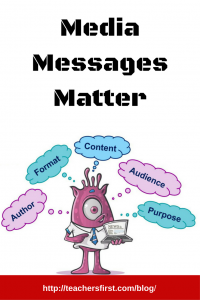 We are inundated with media messages – be it in traditional print formats or digital texts, images, videos, or advertising. As adults, we have the experience and ability to interpret and often ignore the constant barrage of information that confronts us. However, our students do not have the expertise to handle all the extraneous information pouring into their brains every day. In November 2016, Stanford University shared a study of middle and high school students that showed they were unable to tell which online sources are credible information. Students often could not distinguish between news, fake news, and advertising. Read more details in the executive report Evaluating Information: The Cornerstone Of Civic Online Reasoning.
We are inundated with media messages – be it in traditional print formats or digital texts, images, videos, or advertising. As adults, we have the experience and ability to interpret and often ignore the constant barrage of information that confronts us. However, our students do not have the expertise to handle all the extraneous information pouring into their brains every day. In November 2016, Stanford University shared a study of middle and high school students that showed they were unable to tell which online sources are credible information. Students often could not distinguish between news, fake news, and advertising. Read more details in the executive report Evaluating Information: The Cornerstone Of Civic Online Reasoning.
The ACT surveyed high school students regarding their news consumption. In Checking What Students Know about the News, the ACT’s report stated that since fake news continues to be a national issue. “Given the proliferation of news sources and students’ access to them, educators (and parents) should take steps to help students prioritize fact-checking in their reading and work to better distinguish between real and fake news stories and sources and to help ensure that students are basing their views on factual information.” The report concluded, “Our study, as well as other recent research, suggests that students will be better equipped to evaluate news sources if they have received appropriate instruction. Based on the survey findings, we recommend schools and districts develop courses to teach students how to differentiate between accurate, reliable information and inaccurate, unreliable information.”
To understand the concept of media literacy, begin with the basics by watching the archived recording of a recent OK2Ask webinar, Fostering Accountability, Media Literacy in the Classroom. Then check out these suggestions.
Definition of Media Literacy, a component of Digital Citizenship and Information Literacy.
- The Center for Media Literacy gives this definition. “Media Literacy is the ability to access, analyze, evaluate and create media in a variety of forms.”
- Plus, this expanded explanation. “Media Literacy is a 21st-century approach to education. It provides a framework to access, analyze, evaluate, create and participate with messages in a variety of forms — from print to video to the Internet. Media literacy builds an understanding of the role of media in society as well as essential skills of inquiry and self-expression necessary for citizens of a democracy.”
Resources for Developing a Media Literacy Curriculum
- Essential Books
- Baker, Frank W. Media Literacy in the K-12 Classroom, 2nd ed. ISTE, Portland, OR, 2016.
- Hobbs, Renee, Discovering Media Literacy: Teaching Digital Media and Popular Culture in Elementary School, Corwin, Thousand Oaks, CA, 21013.
- Five Laws of Media and Information Literacy Infographic. UNESCO states, “We are travelling towards the universality of books, the Internet and all forms of containers of knowledge … Media and information literacy for all should be seen as a nexus of human rights.”
- Six Core Principles of Media Literacy from the National Association for Media Literacy Education
- Media Smarts, Canada’s extensive Media Literacy Curriculum
- State Standards Chart from Media Literacy Clearinghouse
- Media Literacy Now includes videos and other materials
Classroom Ideas and Activities
- Chart of 5 Key Questions from the Center for Media Literacy. The core of Media Literacy is “five key questions which can be used to analyze and evaluate any item of text or other forms of media.” Using this strategy can help our students determine if what they read, see and watch online is accurate. The critical questions to ask are:
- Authorship–All media messages are “constructed.” Who created this message?
- Form –Media messages are constructed using a creative language with its own rules. What creative techniques are used to attract my attention?
- Audience–Different people experience the same media message differently.How might different people understand this message differently from me?
- Content–Media have embedded values and points of view. What lifestyles, values and points of view are represented in; or omitted from, this message?
- Purpose–Most media are organized to gain profit and/or power. Why is this message being sent?
- 5 Key Questions That Can Change the World. Background and lesson plan ideas
- Media Literacy Resources from Edutopia
- TeachThought: 50 Challenging Activities To Promote Digital Media Literacy In Students, ideas to use in every content area
- PBS LearningMedia News and Media Literacy Collection includes videos, articles, handouts, and lesson plans.
After we have taught our students to be better critical thinkers and more thoughtful consumers of media, our next step is to help our students become creators. By motivating our students to use higher order thinking skills as producers of media and digital content, we engender classroom engagement as they become more media literacy savvy. Looking for more ideas? The resource page from the OK2Ask webinar on media literacy has addtional suggestions on how to infuse media literacy in the classroom.


2 thoughts on “Media Messages Matter”